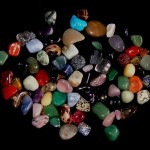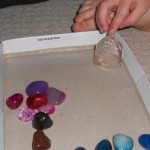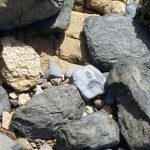Have you wondered why kindergarten readiness and other developmental assessments sometimes ask kids to name shapes? This basic information gives an idea of the level of children’s learning. For instance, shapes belong together in groups so they can be used to tell if a child can categorize using similarities and differences. There is a great deal of thinking to be able to match shapes to other shapes and to the correct words.
Like so many other readiness for kindergarten concepts, the key to learning shapes is exploration and repetition, and play. If your child is past the stage of putting everything into his/her mouth, rocks are a fun way to practice shapes. While most will be round, there will be some that are square, some pointy, etc. How much you can do will depend on kids’ age. For wee ones, you may only be able to say “round” and guide little hands to feel the shape. Older toddlers may be able to compare and name other shapes. Rain or shine, you may want to go for a rock walk around to block or to the park to look for other shape rocks.
In a study just published last month from the University of Chicago, understanding shapes and how they fit together is important knowledge for problem-solving, and for material presented later in school such as maps, graphs and diagrams. As the old saying, what goes around comes around and the learning that kids do from the ages of new to 5 or 6 years old, comes back around when they go to school. Do you have any comments to round off this kindergarten readiness and rock learning activity?



